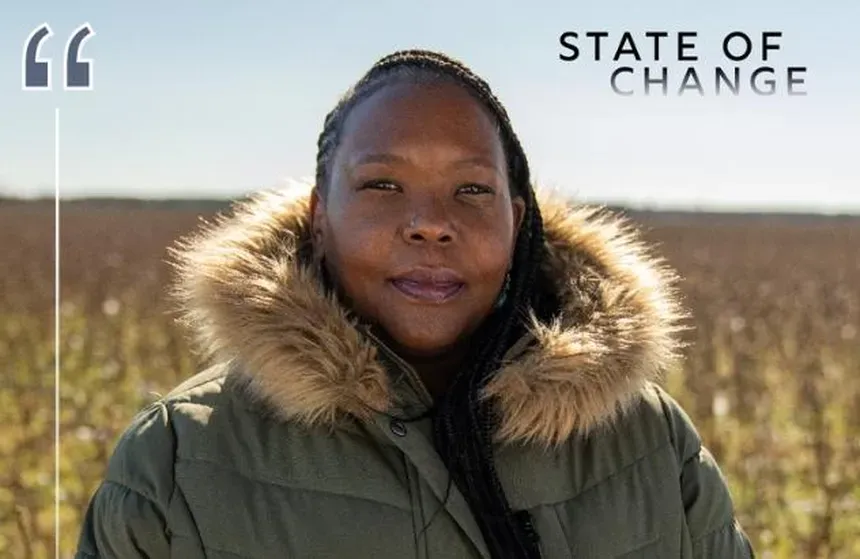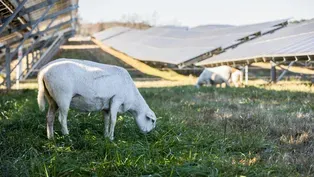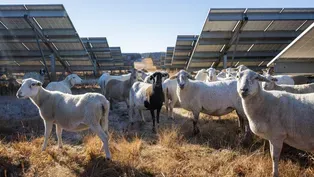
Can solar panels and crops share the sun in the same place?
Clip: Special | 7m 16sVideo has Closed Captions
Could we redesign solar panels so we can harvest crops and renewable energy in the same space?
Solar energy production and farming land benefit from flat, open, sunny fields. But solar panels and crops don't play nicely together; they both need the same thing to be at their peak: sunlight. Researchers like Ricardo Hernandez at NC State are working to redesign the classic solar panel to allow plants to get the sunlight they need while collecting enough to turn it into renewable energy.
State of Change is a local public television program presented by PBS NC
State of Change is part of the Pulitzer Center’s Connected Coastlines reporting initiative. For more information, go to https://pulitzercenter.org/connected-coastlines.

Can solar panels and crops share the sun in the same place?
Clip: Special | 7m 16sVideo has Closed Captions
Solar energy production and farming land benefit from flat, open, sunny fields. But solar panels and crops don't play nicely together; they both need the same thing to be at their peak: sunlight. Researchers like Ricardo Hernandez at NC State are working to redesign the classic solar panel to allow plants to get the sunlight they need while collecting enough to turn it into renewable energy.
How to Watch State of Change
State of Change is available to stream on pbs.org and the free PBS App, available on iPhone, Apple TV, Android TV, Android smartphones, Amazon Fire TV, Amazon Fire Tablet, Roku, Samsung Smart TV, and Vizio.

Explore More from State of Change
Hear from North Carolinians about climate change effects & innovative solutions across the state.[thoughtful music] - [Narrator] Generating electricity from the sun is efficient and renewable.
But solar installations can take up a lot of land, and often the best sites to build them on are farmland.
- Typically, they have a comfortable slope and level.
They're typically already clear, and they're always, you know, full exposure to the sun.
However, you know, that farmland is needed to produce food, and if we remove the capability of producing food in this farmland, we have removed our ability to feed the population in the world.
So there is a conflict.
- [Narrator] That conflict could be resolved by combining solar energy generation with farming through something called agrivoltaics.
- Agrivoltaics is the combination of agriculture and photovoltaic panels.
And the idea behind it is, can we use the land for dual purposes?
Can we grow crops in the field, in the soil, and can we harvest the solar energy to generate electricity?
Great idea, but there is some challenges around it.
- [Narrator] Solar panels and crops in the same field compete for sunlight because the solar panels are harvesting the same light that plants need to grow.
So the challenges designing a way that plants and panels can share.
[bright music] Ricardo is part of a multinational team working to solve this challenge by splitting the sunlight between solar panels and the crops around them.
Sunlight can be broken down into different types of radiation based on wavelength, ranging from 320 nanometers all the way up to 3000 nanometers.
And a portion of those wavelengths is what we call visible light.
Visible light ranges from around 380 nanometers to 750 nanometers.
- Our eyes can detect that light.
Similar range is also for the plants to do photosynthesis.
If you deploy these panels, you're going to be removing those essential wave lengths and the plant will actually have a big penalty in yield.
We don't want to penalize the production of food or the production of plant growth because we already don't have enough farmland in the world to grow crops.
We want to prioritize plant growth.
So in order to do that, we're trying to actually split the sun.
[thoughtful music] - I visited a greenhouse on NC State's campus to learn more about how the team is splitting sunlight.
Tell me about this piece of glass here.
It looks like an ordinary piece of glass, but what is unique about it?
- Yeah, so this piece of glass has optics in the middle.
It's film, and this film is what causes the reflection of absorption of a specific wavelengths.
- Glass like this is often used in office buildings where architects want to reduce the heat load of sunlight coming into the building without reducing the amount of natural light.
So they use glass designed to let visible light through while reflecting radiation with a longer wavelength, like infrared light.
Ricardo and his team are hoping to use glass like this to let plants get the spectrum of light that they need to grow while harvesting the rest of the sunlight's radiation for solar energy production.
Sensors show us that the glass is blocking about half of the total light or solar radiation that is present in the greenhouse and a slightly lower percentage of the photosynthetically active radiation.
This is measuring what plants would use to live, grow, do their things.
- And do photosynthesis.
We want maximize the amount of light that reaches the plant, so we want to reduce the amount of light that is reflected or absorbed by the optics to remove some because of the inefficiencies.
So that's an improvement that we can do through research.
But then you can see that you still have a lot of light going through.
- Still a lot of light that, if this was in the field and sun is coming through, a lot of light could still get to the plants underneath.
- Correct.
- A third sensor tells us what part of the sunlight spectrum the glass is reflecting.
- And this is actually what's inside the greenhouse now.
You can see it's a pretty balanced spectrum.
But now, if we move that sensor and it's right on the glass, you're going to see how that spectrum changes.
- [Narrator] This sensor shows us that the wavelengths of light reflected by the glass are mostly useless to plants, but could be harvested for solar energy production.
- You can see how we actually remove some of those wavelengths that are closer to the infrared.
- And the plants really don't need that additional piece of the light spectrum.
It's just really making them hot and thirsty.
- It's making them transpire.
Exactly.
Making them hot and thirsty.
[bright music] - To use this glass in combination with solar panels, some changes have to be made to the traditional setup.
What is it going to look like when it's in the field as you start to develop it?
How will this be set up with a solar panel to actually gather electricity and also let light through to the plants?
- Yeah, so the basic idea is you have your solar panel that is oriented, you know?
Instead of having the sun on top and harvesting, you orient it this way.
And then you have, so can you stand your hand?
This is your solar panel oriented.
It's not like this, it's like this.
And then you have this glass on a 45-degree angle, right?
So the sun, the visible radiation is going to go through, and then the infrared is going to bounce on a 45-degree angle, because this is a 45, and capture by the photovoltaic cell.
And you have a mirror image or the same thing on the other side.
- Okay.
So from both sides, our panel is straight up and down, set up at an angle, but we're bouncing light and hitting both of those sides of the panel.
- Both sides.
- Very cool.
For Ricardo and his collaborators, the goal is for solar installed alongside agriculture to have minimal impact on the farmland's productivity.
- The number one priority of this research is to minimize the yield penalty, maximize plan growth, but still be able to collect enough energy to make the technology feasible for growers.
So we don't want to eliminate the revenue stream of the crop, but we want to add an additional revenue stream by creating energy.
[casual music] - [Narrator] To test how much impact new solar panel designs might have on crops, they use mathematical models with known information about how a lettuce or tomato plant reacts to things like less light to predict the crop's yield in different scenarios.
Shade-loving crops like lettuce only need a few more days in the field to have the same yield.
But for sun-loving crops like tomatoes, the penalty is much higher, up to 25 to 30% reduction in yield.
So there's still room for improvement.
- So there's still a lot of research for this to be something tangible, but at least we have that small piece of evidence that we were looking for.
But we want to prevent the farm from becoming real estate.
We want to prevent the farm for becoming only a solar farm.
So we want to preserve our farmland in North Carolina.
If this will allow farmers to keep the land farming with additional revenue income, that's already a win.
If we can preserve 10 acres from switching, that's already a win.
[casual music continues]
How Sheep Make Solar Energy Production Easier
Video has Closed Captions
Sheep and solar panels work hand in hand to generate enough power for a small town. (7m 7s)
Preview | State of Change: Solar Harvest
Video has Closed Captions
Find out how North Carolinians are generating solar energy alongside agriculture. (30s)
Providing Support for PBS.org
Learn Moreabout PBS online sponsorshipState of Change is a local public television program presented by PBS NC
State of Change is part of the Pulitzer Center’s Connected Coastlines reporting initiative. For more information, go to https://pulitzercenter.org/connected-coastlines.













